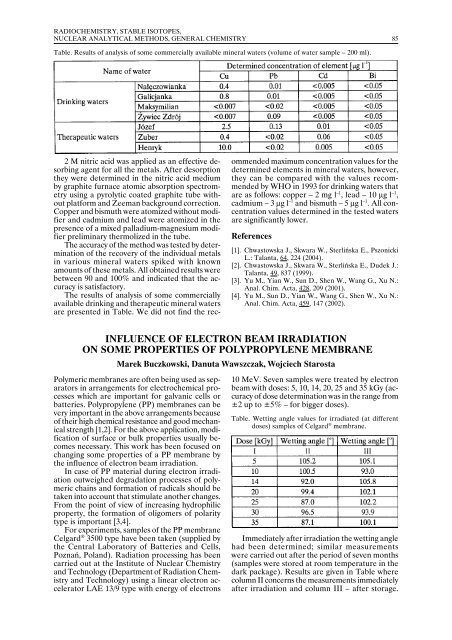annual report annual report annual report annual report 2005
annual report annual report annual report annual report 2005
annual report annual report annual report annual report 2005
You also want an ePaper? Increase the reach of your titles
YUMPU automatically turns print PDFs into web optimized ePapers that Google loves.
RADIOCHEMISTRY, STABLE ISOTOPES,<br />
NUCLEAR ANALYTICAL METHODS, GENERAL CHEMISTRY<br />
85<br />
Table. Results of analysis of some commercially available mineral waters (volume of water sample – 200 ml).<br />
2 M nitric acid was applied as an effective desorbing<br />
agent for all the metals. After desorption<br />
they were determined in the nitric acid medium<br />
by graphite furnace atomic absorption spectrometry<br />
using a pyrolytic coated graphite tube without<br />
platform and Zeeman background correction.<br />
Copper and bismuth were atomized without modifier<br />
and cadmium and lead were atomized in the<br />
presence of a mixed palladium-magnesium modifier<br />
preliminary thermolized in the tube.<br />
The accuracy of the method was tested by determination<br />
of the recovery of the individual metals<br />
in various mineral waters spiked with known<br />
amounts of these metals. All obtained results were<br />
between 90 and 100% and indicated that the accuracy<br />
is satisfactory.<br />
The results of analysis of some commercially<br />
available drinking and therapeutic mineral waters<br />
are presented in Table. We did not find the recommended<br />
maximum concentration values for the<br />
determined elements in mineral waters, however,<br />
they can be compared with the values recommended<br />
by WHO in 1993 for drinking waters that<br />
are as follows: copper – 2 mg l –1 , lead – 10 µg l –1 ,<br />
cadmium – 3 µg l –1 and bismuth – 5 µg l –1 . All concentration<br />
values determined in the tested waters<br />
are significantly lower.<br />
References<br />
[1]. Chwastowska J., Skwara W., Sterlińska E., Pszonicki<br />
L.: Talanta, 64, 224 (2004).<br />
[2]. Chwastowska J., Skwara W., Sterlińska E., Dudek J.:<br />
Talanta, 49, 837 (1999).<br />
[3]. Yu M., Yian W., Sun D., Shen W., Wang G., Xu N.:<br />
Anal. Chim. Acta, 428, 209 (2001).<br />
[4]. Yu M., Sun D., Yian W., Wang G., Shen W., Xu N.:<br />
Anal. Chim. Acta, 459, 147 (2002).<br />
INFLUENCE OF ELECTRON BEAM IRRADIATION<br />
ON SOME PROPERTIES OF POLYPROPYLENE MEMBRANE<br />
Marek Buczkowski, Danuta Wawszczak, Wojciech Starosta<br />
Polymeric membranes are often being used as separators<br />
in arrangements for electrochemical processes<br />
which are important for galvanic cells or<br />
batteries. Polypropylene (PP) membranes can be<br />
very important in the above arrangements because<br />
of their high chemical resistance and good mechanical<br />
strength [1,2]. For the above application, modification<br />
of surface or bulk properties usually becomes<br />
necessary. This work has been focused on<br />
changing some properties of a PP membrane by<br />
the influence of electron beam irradiation.<br />
In case of PP material during electron irradiation<br />
outweighed degradation processes of polymeric<br />
chains and formation of radicals should be<br />
taken into account that stimulate another changes.<br />
From the point of view of increasing hydrophilic<br />
property, the formation of oligomers of polarity<br />
type is important [3,4].<br />
For experiments, samples of the PP membrane<br />
Celgard ® 3500 type have been taken (supplied by<br />
the Central Laboratory of Batteries and Cells,<br />
Poznań, Poland). Radiation processing has been<br />
carried out at the Institute of Nuclear Chemistry<br />
and Technology (Department of Radiation Chemistry<br />
and Technology) using a linear electron accelerator<br />
LAE 13/9 type with energy of electrons<br />
10 MeV. Seven samples were treated by electron<br />
beam with doses: 5, 10, 14, 20, 25 and 35 kGy (accuracy<br />
of dose determination was in the range from<br />
±2 up to ±5% – for bigger doses).<br />
Table. Wetting angle values for irradiated (at different<br />
doses) samples of Celgard ® membrane.<br />
Immediately after irradiation the wetting angle<br />
had been determined; similar measurements<br />
were carried out after the period of seven months<br />
(samples were stored at room temperature in the<br />
dark package). Results are given in Table where<br />
column II concerns the measurements immediately<br />
after irradiation and column III – after storage.
















